This article was originally published as the feature and center spread cover story in Urban Moto magazine Issue 43, June 2008. This was their first ‘Green’ Issue. This article is about Michael Sturtz, founder of the Crucible. I talk about the man, how he built a bio diesel motorcycle that broke a land speed record, his organization the Crucible, fire, and how he is green.
Here is a link to the article on Urban Moto’s site [site is now gone].
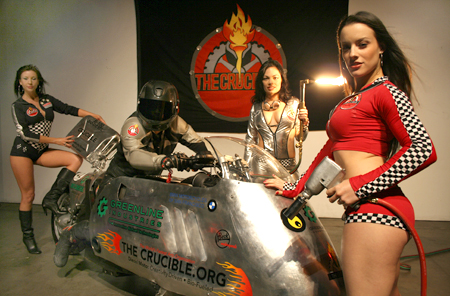
From left to right: Aliena, Matt Rhea, Kristina Cańizares, Leah Gonzalez. Matt is one of the Diesel Dozen, The rest are from the The Nekyia dance troupe. Photo: Sarah Chaput
Making Biodiesel Sexy
by Torrey Nommesen
Michael Sturtz & The Crucible
When I walked up to do the photo shoot, there was this kid walking out with a beautiful Mandolin. I asked him where he got it, and he smiled and said‚ ”I made it!” Along with a long list of class offerings including welding, blacksmithing, foundry, glass working, woodworking, and ceramics, they teach a class on how to make a Mandolin.
If there is something you want to learn how to make, they probably teach it here. You can also learn, among many other things, how to make jewelry, work with neon, make a low rider bicycle, fix your motorcycle, build robots, and dance with fire. This is all part of Michael Sturtz’s vision manifest at a warehouse in West Oakland a block from the BART and right off the I-880.
Before founding the Crucible, Michael had a career as a sculptor. His works are exhibited all over the world, and are in collections in California, Chicago, Vermont, New York, Texas, Italy and England. He was making, selling and teaching sculpture quite successfully. His bio says in humble yet perfect art-speak that “his pieces address both concept and form through the creation of intriguing kinetic machines and strong material contrasts that often include creative mixtures of stone, cast and fabricated metals, glass, kinetics, light, fire, liquid and video.”

To become this Artist, he chased art schools from Los Angeles to New York to Italy and finally the Art Institute of Chicago where he left with his MFA to go back home to the East Bay. Along the way he was teaching – as an artist, that’s how you pay the bills between commissions. But more importantly, he was always trying to find the right person to teach him what he wanted to know. He never quite found that person. So he decided to become that person himself.
With his knowledge of sculpture and teaching, in 1999 he founded The Crucible, a nonprofit sculpture studio, educational foundry and metal fabrication shop. But his warehouse is more than just a school, it is a hope for the community and beacon from the Bay Area to the rest of the world.
Along with world class training in the fine and industrial arts, it serves as an arts venue for the general public, and it does youth and community outreach. One of the cool things they do is the free Earn-A-Bike program where kids work on donated bikes and get to keep them after they’ve fixed them.
Another great outreach is the ERV, or Educational Response Vehicle. It is a restored 1960 International fire truck with a full metal shop on board. Demonstrations of glass flameworking, welding, torch cutting, casting and blacksmithing take place on the traveling ERV, which is also equipped with a crane and a 30 ft flamethrower. Most fire departments have a water truck – this one is a real fire truck!
The shows they have in their venue are mind blowing. I went to see their 5th theatrical performance, Firebird: “L’oiseau de feu” recently. It was a fire ballet that featured (lots of fire and) a duet with a ballet dancer and a motorcycle stunt rider. Last summer for a rendition of Homer’s Oddessey, they built an 8000 gallon moat around the stage and had a fire and water theme. They also have the Fire Arts Festival every July which is a huge event drawing over 10,000 people to see fine art, huge interactive fire-breathing sculpture, a Tesla coil, and performances.
Fire is the mascot of the Crucible. All their performances feature it. You can build fire sculpture or learn how to dance with it. There’s a lot of good metaphor with fire that applies to the Crucible – the campfire as a gathering spot where people share stories and build community, creative energy is the fire within, and there is the fire-like passion of the lovers and heros in the classical ballets and operas that are re-interpreted and performed there. When pressed on this obsession with fire, Michael told me that he was never quite the pryo that everybody thinks he is. One of his goals is to re-educate people about fire. As he says, “it’s not all about arson and blowing things up – it’s about creating as well.”
And there’s a lot of space there to create. The school takes up half a city block and has large studio spaces that you can rent. They have every kind of equipment you can imagine to shape, mold or build in just about any material.
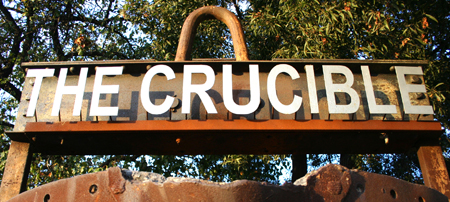
The sign out front welded to a crucible. Photo: Sarah Chaput
Michael Sturtz & The Crucible
On the roof of the building, Michael installed 240 solar panels. The panels generate electricity to sell back to the electric company at peak daytime hours. Since the classes are mostly at night, they tend to use power when it is cheaper during off peak hours. As a bonus, when the electricity prices went up shortly after installing the panels, they were able to sell the power back at a higher rate than they anticipated. This brings me to the reason he is featured in our [Leslie: put correct title here] Issue. Because Michael is an eco friendly bike nut, and he’s working on an amazing project: Die Moto.
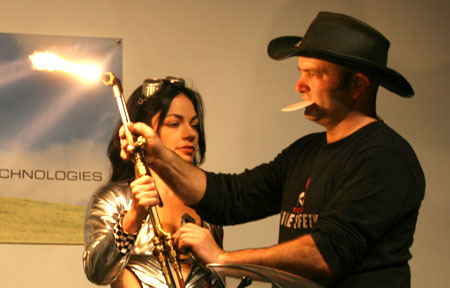
Michael Sturtz adjusts the flame for the photo shoot. Photo: Sarah Chaput
Michael holds the world land speed record for a diesel motorcycle, and he did it running on B100 biodiesel. Last September, he clocked 130.614 mph at Bonneville. Really that’s not really fast though. I’ve reached that velocity with my sportbike bike on an open freewa- I mean controlled racetrack environment. And admittedly, they were going for low hanging fruit – the last record was a mere 105 mph. But it’s not as much about breaking records as it is about environmental responsibility and alternative technology that can result in a high performance motor vehicle. It’s about grabbing headlines and showing the world that you don’t have to be a hippy to save the planet. It’s about making biodiesel is sexy.
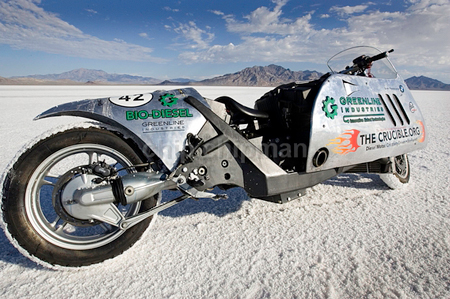
The DieMoto bike. Photo: Chip Chipman
Part of the less than amazing run at Bonneville (they’ve got guys breaking the sound barrier out there) was due to the on board computer. It wasn’t letting the engine give it’s optimal performance that day on the sand. Learning to decode and reprogram it has proven to be quite a task. The engine uses BMW’s Digital Diesel Electronics (DDE). This is supposed to monitor things like the position and pressure on your foot pedal to know when to inject the right amount of fuel, and getting the perfect fuel mixture to minimize emissions and maximize power. It is also responsible for figuring out if the key is in the ignition when trying to start it. But when you rip the thing out of a precision German engineered car and stick it in a custom fabricated motorcycle, it freaks out. After weeks building a frame, linking the disparate pieces together, and creating a fuel-delivery system with biodiesel-compatible parts, the computer decided that someone stole the car it was in and the computer shut down for four days. Michael had to beg BMW for the security codes to get it running.
There’s more on the road of trials of the hero’s journey. At their first attempt, Bonneville got rained out, so no one got in a run. They were going to go try to run on straight vegetable oil (SVO) that day and create a new category. Imagine going out there with all the guys using the highest octane gas they can get, and some guy shows up with veggie oil burning machine. They petrol heads were skeptic at first, but eventually became really positive about what he was doing. Next year, if he can exorcise the ghost in the machine, he hopes to break 160 mph.
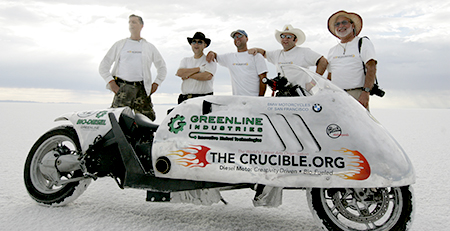
Some of the Diesel Dozen out on the salt flats. From left to right: Henry Boyle, Ken Gilliland, Danny Dillon, Michael Sturtz and Steve Bayles. Photo: Chip Chipman
Of course it’s not just him out there. He’s got a team of volunteers known as The Diesel Dozen – a bit of a misnomer since there are more like 50 of them (about 10 of them made it out to the salt flats). The group is comprised of highly skilled professionals in the fields of engineering, motorcycle mechanics, design, fabrication, environmental health, and industrial arts. Under Michael’s direction, they crafted Die Moto using a 2004 BMW 320D engine, two radiators ripped from a couple of Honda Civics, and some BMW R1150RT motorcycle parts. Except for some of the controls, not much is left of the original R1150 (Leslie: ask Dan if there is a cooler way to refer to this model of bike). Everything else, they built from scratch at The Crucible. And the thing is street legal!
One of the perks of owning and operating an industrial complex is that you get to build stuff. And since it happens to be a school as well, you have extra hands. When you look under the faculty section of the Crucible’s website, Michael is listed as teaching “Special Projects.” In other words, he teaches what he likes to call “Tom Sawyer classes” where he charges students to help him and a team of professionals in various fields to work on his crazy projects. It’s not like the students are being ripped off – they learn some really valuable skills. The ERV was part of a class on restoring 1960s fire engines. He recently had a class on railroad train caboose refurbishing so that he would have a ticket office outside that’s made out of one. His student learned carpentry, metal fabrication, electrical wiring etc. on that one. Next he plans on teaching a class on how to build a small kitchen and the Crucible gets a cafe. And Die Moto was one of these Tom Sawyer projects.
The fairing is made of hand crafted aluminum. It looks like a GP race bike of yester-year. To make it, they needed an English Wheel. So they built one, and now there’s a workshop in how to mold aluminum with an English Wheel. And the biodiesel for the bike? You can now take a course in how to ferment your own batch of it.
One last class to mention to our readers, is one called the Art of Motorcycle Repair. No experience required. You can tow in your hunk of junk with 2 (or even less) wheels and ride it out when you’re done.
The ERV and the Die Moto will be on display at the Maker Faire here in San Mateo by the time this article hits the press. But Michael won’t be there – he’s off adventuring in Australia. He rented a superbike and is going to tour the land down under and stop off to give a guest lecture before hitting New Zealand to help set up a sculpture and foundry studio for a school down there.
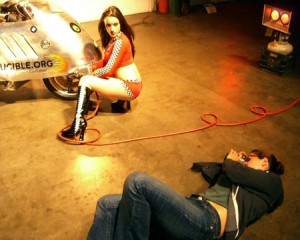
Sarah Chaput photographs Leah Gonzalez on the DeiMoto. Photo: Torrey Nommesen
For more information, visit these websites:
The Crucible
The Die Moto project
Michael Strutz’s homepage
The Maker Faire